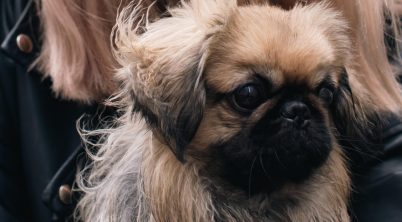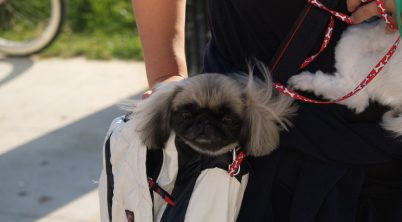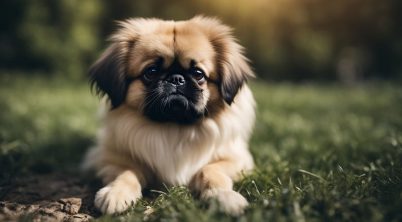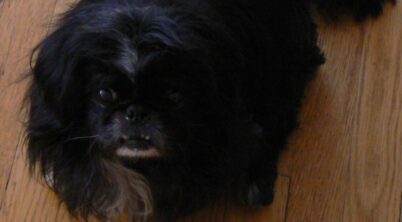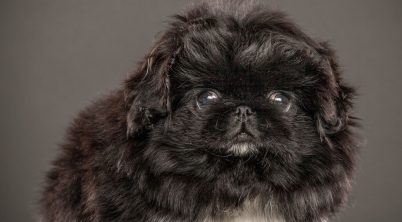Grooming a Pekingese requires an attentive and regular routine due to its long, flowing coat. Originating from China, this small, toy breed is known for its lion-like mane and distinctive appearance which demands consistent care. Proper grooming not only ensures that these dogs look their best, but it also plays a crucial role in their overall health and comfort.
The Pekingese coat consists of a thick undercoat and a long outer coat, which can easily become matted without the correct grooming techniques. Brushing several times a week, if not daily, is essential to prevent tangles and remove dirt and debris. Routine maintenance also includes cleaning their facial wrinkles, caring for their teeth, and ensuring their eyes are clear and free from irritation.
Considering the specific needs of Pekingese grooming, owners must equip themselves with the right tools and knowledge. Grooming practices can cover a spectrum from basic home care to professional grooming sessions, depending on the owner’s preference and the dog’s needs. Regular grooming not only preserves the dog’s regal appearance but also fortifies the bond between the Pekingese and its owner, making it an integral part of the Pekingese’s care regimen.
Table of Contents
Understanding the Pekingese Coat
The Pekingese breed is celebrated for its luxurious double coat that requires thorough care to maintain its regal appearance.
Structure of the Pekingese Fur
The Pekingese possesses a double coat consisting of a long, coarse outer coat and a thick, soft undercoat. This combination gives the Pekingese its fluffy coat appearance that many owners cherish. The lion-like mane, or ruff, around the neck is one of the breed’s most prominent features, contributing to its distinguished look.
Shedding and Undercoat
Shedding is a natural process for Pekingese, with seasonal peaks typically occurring during spring and fall. Their dense undercoat, while insulating, requires regular attention to manage shedding and prevent the formation of mats and tangles.
- Spring: Increased shedding as the coat lightens for warmer weather.
- Fall: Preparation for a heavier winter coat leads to another shedding period.
Significance of Regular Grooming
Regular grooming is not merely aesthetic; it’s essential for the Pekingese’s health and comfort. Without frequent brushing (at least twice weekly):
- Mats can form close to the skin.
- Tangles can lead to discomfort and even skin infections.
Consistent care prevents matting and distributes natural skin oils throughout the coat, which is vital for maintaining the integrity and splendor of the Pekingese’s fur.
Basic Grooming Requirements
Proper grooming is an essential aspect of Pekingese care, aimed at maintaining their luxurious coat and overall health. Regular grooming not only enhances the dog’s appearance but also allows for early detection of potential skin and health issues.
Grooming Tools and Essentials
A comprehensive grooming toolkit is crucial for Pekingese owners. Essential tools include:
- Slicker brush: To effectively remove loose fur and prevent matting.
- Natural bristle brush: For a smooth and shiny finish on the coat.
- Comb: To detangle fur, especially around sensitive areas like the face and paws.
- Nail clippers: To keep nails at a comfortable length and avoid overgrowth that can cause discomfort or injury.
- Scissors: For trimming around the feet and hygiene areas.
Grooming products such as shampoo and conditioner should be suitable for a Pekingese’s sensitive skin and coat type.
Establishing a Grooming Routine
Developing a consistent grooming routine is pivotal. They should brush their Pekingese several times a week using both the slicker brush and the natural bristle brush, working through knots gently to avoid discomfort. Nail clipping should be done carefully to prevent cutting into the quick, and baths should be given as needed – typically every few weeks unless the dog becomes particularly dirty. Regular ear cleaning prevents infections, and attention to dental hygiene wards off periodontal disease. Establishing these habits early on sets the stage for a well-maintained and happy Pekingese.
Bathing Your Pekingese
Bathing a Pekingese involves careful attention to maintain their unique coat’s health without causing skin irritation. Proper preparation, suitable bathing techniques, and effective post-bath care are essential to a clean and happy dog.
Pre-Bath Preparations
Before starting the bath, ensure the Pekingese’s coat is free of mats and tangles. Brush thoroughly, especially in areas prone to knotting, to prevent any washing-related matting. Inspect the coat for loose hair and remove as much as possible; this lessens complications both during and after the bath.
- Always check the skin for irritation or inflammation.
- Prepare all supplies beforehand: dog-friendly shampoo, conditioner (if needed), and towels.
Bathing Techniques
When bathing your Pekingese, choose a shampoo with no harsh chemicals to avoid skin issues. Shampoos should be gentle and specifically designed for dogs. Here’s a basic guide to the bathing process:
- Wet the coat evenly with warm water, avoiding the face.
- Apply a small amount of shampoo and gently massage it into the coat, creating a lather.
- Rinse thoroughly to ensure no shampoo residue remains, which could cause irritation.
- If using conditioner, apply it now following similar steps as the shampoo.
- Remember to clean the facial area with a soft, damp cloth to avoid soap getting into the eyes.
Post-Bath Care
After bathing, it is crucial to dry your Pekingese properly:
- Towel dry by gently rubbing to remove excess water. Do not rub vigorously as this can tangle the fur.
- Use a low-heat blow dryer to carefully dry the coat, keeping the dryer at a safe distance to prevent burns or discomfort.
- Continue to brush the coat as it dries to avoid any matting.
- Always reassure and calm your Pekingese throughout the drying process.
Brushing and Combing

Proper brushing and combing are critical for maintaining the Pekingese’s long, flowing coat. These practices help prevent matting, remove debris, and preserve the coat’s natural luster.
Brushing Frequency
For a Pekingese, regular brushing is essential to keep their coat in good condition. Owners should aim to brush their Pekingese a few times a week, with daily brushing being ideal to prevent mats and tangles, especially behind the ears and under the tail.
Techniques for Detangling
When detangling a Pekingese’s coat, one should start by gently separating the mat with their fingers. Following this, a slicker brush may be used to carefully ease out tangles. If necessary, a mat splitter or de-matting tool can assist in removing stubborn mats without cutting the coat.
- Start: from the roots and move towards the ends.
- Gentle strokes: to avoid hurting the skin.
- Areas of focus: behind the ears, chest, and under the tail.
Brushing vs. Combing
While brushing distributes natural oils and removes loose fur, combing with a fine-tooth comb is more effective for getting rid of small mats and debris.
| Action | Tool | Benefit |
|---|---|---|
| Brushing | Soft bristle brush | Removes loose fur, spreads oils. |
| Combing (Final) | Fine-tooth comb | Detailed work on mats, cleans up debris. |
| Debris Removal | Lint roller (optional) | Can be used post-brushing to pick up stray hairs on the coat. |
Brushing should be thorough, reaching down to the skin to ensure all layers of the coat are groomed, but it should also be gentle to prevent skin irritation. Combing should follow brushing to fine-tune the grooming process and ensure a completely mat-free coat.
Managing Mats and Tangles
Proper grooming of a Pekingese’s coat is essential to prevent mats and tangles, which, if left unaddressed, can lead to discomfort and even pain for the dog. The Pekingese’s long, thick hair is particularly prone to such issues and demands regular care.
Daily Brushing: The cornerstone of managing a Pekingese’s coat is daily brushing. It is advised to use a slicker brush to effectively detangle the hair and remove loose fur. One should start at the head and gently work down to the tail, taking care not to pull too hard to avoid causing the dog discomfort.
Tools to Use:
- Slicker Brush: Ideal for removing tangles and loose hair.
- Fine-tooth Comb: To work through finer mats and to give a finished look.
- Mat Splitter or De-matting Tool (if necessary): Useful for tackling tougher mats.
To handle mats, gentle strokes should be employed, paying extra attention to undercoat areas that are more susceptible to matting. If a mat is encountered, a comb can be used to gently tease it apart. Severe mats may require careful use of a mat splitter. One must never forcefully pull or cut mats without the proper knowledge, as this could harm the dog’s skin.
Bathing: Regular bathing every 3-4 weeks will also help prevent tangles from setting in. However, one should make sure to thoroughly brush the dog’s coat before each bath to avoid turning existing tangles into mats under the wet conditions.
By sticking to these guidelines, one can maintain a Pekingese’s coat in a smooth, tangle-free condition, ensuring the dog’s well-being and comfort.
Nail and Paw Care
Pekingese dogs require consistent nail trimming and paw care to maintain their comfort and mobility. Proper attention to nails and paws not only keeps the dog looking tidy but also prevents potential health issues.
Trimming Nails Regularly
Regular nail trims are vital to prevent a Pekingese’s nails from growing too long, which can lead to difficulty walking and potential injury. Owners should use nail clippers designed for dogs. It’s crucial to avoid cutting into the quick, as it can cause pain and bleeding. For light-colored nails, the quick is visible, but for darker nails, one must clip small bits at a time to avoid it. If unsure, consulting a professional groomer or veterinarian can be helpful.
Paw Hygiene
Beyond nail care, paw hygiene is equally important for a Pekingese’s well-being. Owners should inspect their dog’s paws and pads regularly, checking for any signs of injury, such as cuts or cracked pads which can be indicative of an issue. The Pekingese’s hair around the paws should be kept trimmed to prevent matting and the buildup of debris. After walks, one should clean the paws to remove any salt, dirt, or harmful substances that the dog may have stepped on.
Ear and Eye Hygiene
Proper grooming of the Pekingese’s ears and eyes is crucial to prevent infections and maintain their overall health. Attention to detail and a gentle approach can ensure both are kept in good condition.
Cleaning Ears Properly
When cleaning a Pekingese’s ears, one should first inspect the ear for any signs of dirt, wax buildup, or possible infection. It’s important to clean only the parts of the ear that are visible to avoid damage to the ear canal. A soft cloth or a cotton ball dampened with a vet-approved ear cleaner should be used. Gently wipe away any debris from the outer ear and the area behind the ears, taking care not to insert anything into the ear canal itself.
Maintaining Healthy Eyes
For the eyes, routine care includes checking for any tearing or discharge that may accumulate around the face. This breed is prone to tear stains, so using a soft, damp cloth to gently wipe around the eyes daily is recommended. It’s vital to avoid the eyes themselves to prevent irritation. Additionally, one should consider a visit to the vet if there is persistent tearing or any signs of an eye infection.
Tail and Rear Grooming
When grooming a Pekingese’s tail and rear, groomers should focus on maintaining cleanliness and preventing matting, given the breed’s long, dense coat. It’s essential to be gentle to avoid causing discomfort or stress to the dog.
Tail Grooming: A Pekingese’s tail is an area of pride, featuring a plume of hair that requires regular care. Groomers should:
- Brush the tail hair daily with a pin brush or slicker to remove tangles.
- Trim excess hair carefully to avoid altering the natural shape of the plume.
- Keep the hair around the tail base tidy to prevent fecal matter adherence.
Rear Grooming: The rear area necessitates a delicate approach due to its sensitivity. Proper grooming entails:
- Using rounded scissors to trim around the dog’s rear, ensuring hygiene and comfort.
- Checking and cleaning the anal glands, which may require professional assistance if full.
Groomers must always inspect both the tail and rear for any signs of infection or parasites, acting swiftly if such issues are detected. Regular grooming sessions not only maintain the Pekingese’s appearance but also their health, making these practices an integral part of the grooming routine.
Dental Hygiene for Pekingese
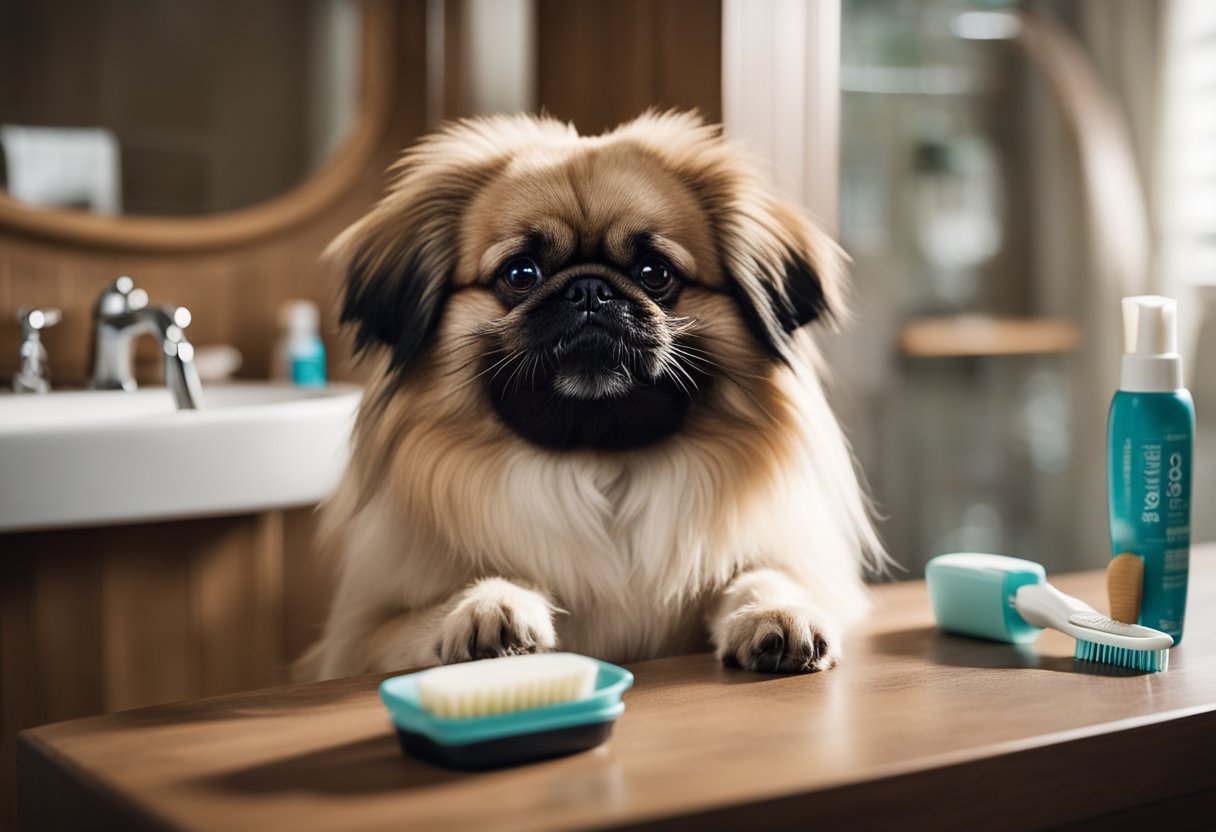
Maintaining dental hygiene in Pekingese is crucial for their overall oral health. These small dogs are susceptible to dental issues, which can lead to more serious health problems if not properly managed. Owners should establish a regular dental care routine to ensure the longevity and well-being of their Pekingese’s teeth and gums.
Daily Brushing:
Brushing a Pekingese’s teeth daily is the gold standard of dental care. A soft-bristled toothbrush and dog-specific toothpaste should be used to prevent the buildup of plaque and tartar. Introduce the practice gradually to make it a positive experience.
- Toothpaste: Use only dog-safe toothpaste, as human products can be harmful to pets.
- Toothbrush: A child-sized toothbrush may be appropriate due to the Pekingese’s small mouth.
Diet and Chew Toys:
In addition to brushing, the Pekingese’s diet can influence oral health. Dry kibble and specially designed dental treats can help scrape away soft tartar. Chew toys are not only beneficial for plaque removal but also serve to strengthen gums and teeth.
- Chew Toys: Select toys that are size-appropriate and made from safe, durable materials.
- Dental Treats: Offer treats formulated to enhance dental health, but always in moderation.
Professional Care:
Regular professional dental cleanings by a veterinarian are imperative. They can help prevent periodontal disease, which Pekingese are prone to due to their small jaw size. A vet can also spot early signs of dental distress and provide timely intervention.
For best practices, Pekingese owners should consult their veterinarian to establish a dental care routine tailored to their dog’s unique needs. Early and consistent care is key to maintaining good oral health and preventing future dental complications.
Professional Grooming Services
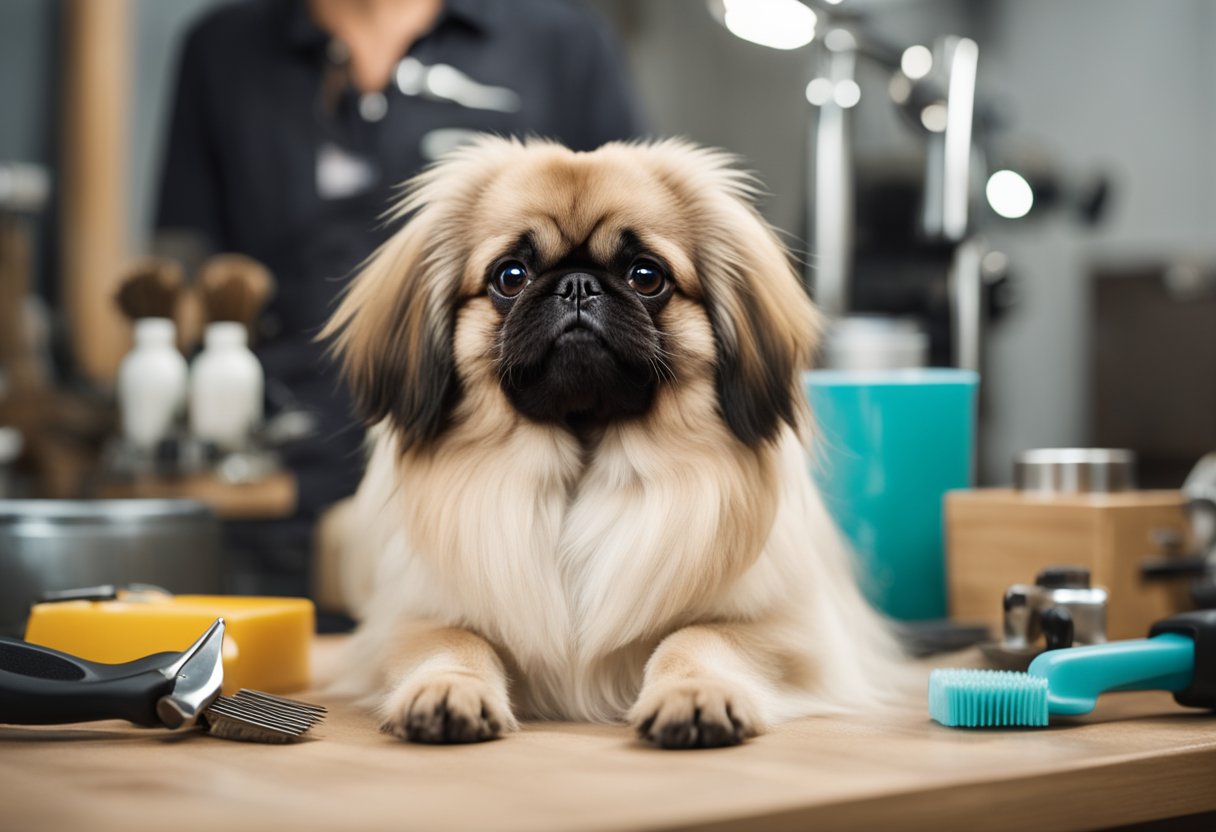
Professional grooming services provide Pekingese owners with expertise and precision in maintaining their pet’s coat and overall appearance. These services align with the breed’s specific grooming needs, ensuring a balance between aesthetic and health.
When to Seek a Professional Groomer
Owners should consider a professional groomer when their Pekingese requires more than a basic at-home grooming routine. This is particularly important:
- Before events: such as dog shows where a Pekingese’s appearance adheres to breed standards.
- For health reasons: when the coat or skin needs professional attention to prevent or address issues, including matting.
- When specialized care is needed: which may include proper nail trimming, ear cleaning, or precise haircuts that maintain the breed’s characteristic appearance.
Benefits of Full Grooming Sessions
A full grooming session with a professional groomer offers multiple benefits:
- Health Maintenance: Professional grooming helps prevent skin infections and parasites, contributing to overall well-being.
- Breed-Specific Grooming: Groomers understand the Pekingese’s unique double coat and provide grooming that enhances its natural shape and style.
- Tools and Techniques: Professionals use the right tools and techniques to groom effectively, such as high-quality brushes, shears, and safe grooming equipment.
By investing in professional grooming services, owners ensure their Pekingese is well-maintained, which can prevent health issues and maintain the dog’s quality of life.
Health Considerations in Grooming
Grooming a Pekingese isn’t just about maintaining its appearance; it’s integral to its health. The breed’s distinct coat and physical characteristics mean that groomers must prioritize the prevention of skin irritation and infections, as well as accommodate any weight and mobility issues.
Avoiding Skin Irritation and Infections
Skin irritation and infections can be a significant concern for Pekingeses due to their dense coats, which can trap dirt and moisture. Here are steps to prevent these issues:
- Regular Brushing: Daily brushing prevents matting, which can harbor bacteria and parasites.
- Clean Wrinkles: Their facial folds require careful cleaning to remove trapped debris.
- Drying: Thorough drying post-bath, especially in dense fur areas, is crucial to avoid moisture-related skin problems.
- Quality Products: Use hypoallergenic shampoos and conditioners to minimize the risk of allergic reactions.
By maintaining these hygiene practices, skin irritations and infections can be minimized effectively.
Dealing with Obesity and Mobility Issues
Obesity can be a challenge with Pekingeses, affecting their mobility and complicating grooming routines. Addressing this includes:
- Weight Monitoring: Regular check-ups to monitor their weight can ensure they stay within a healthy range.
- Grooming Accessibility: A comfortable grooming space accommodates those with limited mobility.
- Support as Needed: Additional support for the Pekingese during grooming sessions helps prevent strain on their joints.
By considering the Pekingese’s size and potential weight issues, groomers can tailor their approach to support the dog’s overall health and wellbeing.
Grooming as Bonding Time
Grooming a Pekingese can transcend the routine of maintenance and become an essential bonding experience between the dog and its owner. It is a practice where trust is nurtured, and positive behavior is encouraged.
Trust Building: For the Pekingese, grooming sessions are opportunities to strengthen the bond with their human. As they become accustomed to being handled, their trust in their owner grows. Consistent, gentle grooming helps establish a sense of safety and familiarity.
- Regular Routine: Establishing a regular grooming routine reassures the dog and can make them more receptive to other forms of training and handling.
Treats and Praise: Utilizing treats during grooming sessions reinforces good behavior. Rewards turn a mundane task into a pleasurable experience for the dog.
- Positive Association: When treats are paired with grooming, Pekingese begin to associate the experience with something enjoyable, leading to a more willing and cooperative demeanor during future sessions.
Behavior Enhancement: Through the focused time spent together during grooming, owners can better understand their Pekingese’s behaviors and needs.
- Observation Time: Grooming offers a perfect opportunity to check for any unusual signs in the dog’s coat or skin, as well as reinforcing desired behaviors outside the grooming context.
In conclusion, grooming should not solely focus on the physical appearance of the Pekingese but also on strengthening the emotional connection between the dog and its owner.
Final Tips and Best Practices
Grooming a Pekingese requires attention to detail and the use of correct techniques and products to maintain their unique coat and wellbeing.
Choosing Hypoallergenic Grooming Products
When selecting grooming products for a Pekingese, it’s essential to choose hypoallergenic options to minimize the risk of skin irritation. These breeds can have sensitive skin, making them more susceptible to allergies.
- Shampoo and Conditioners: Opt for products specifically labeled as hypoallergenic. These should be free from harsh chemicals and additives that could trigger reactions.
- Flea Prevention: Flea control is crucial. Hypoallergenic flea prevention products can protect against fleas without causing adverse skin reactions.
One must also consider the sharpness of grooming tools. Dull tools can pull on the coat painfully and cause stress to the dog.
Proper Drying and Finishing Touches
After bathing a Pekingese, drying is as important as the washing process. Incorrect drying techniques can lead to skin issues and coat damage.
- Towel Drying: Pat the coat gently with a towel. Avoid vigorous rubbing which can tangle the coat and cause matting.
- Blow Drying: Use a low heat setting to avoid overheating the skin. Keep the dryer moving evenly over the coat to dry thoroughly without causing discomfort or burns.
Regular grooming prevents overgrowth of hair that can trap dirt, debris, and parasites. It also helps to inspect for signs of fleas or skin infections during grooming sessions.
* Banner photo by SheltieBoy (Some rights reserved)

